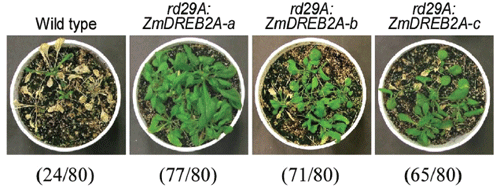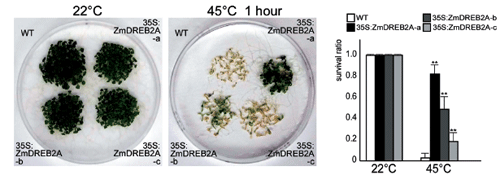The maize transcription factor ZmDREB2A in transgenic plants improves tolerance to drought and heat stress
Description
ZmDREB2A is a DREB2A-type transcription factor isolated from maize. ZmDREB2A expression is induced by cold, dehydration, high salinity, and heat stress in maize seedlings. Unlike Arabidopsis DREB2A, ZmDREB2A produces two forms of transcript, and quantitative real-time PCR analyses have demonstrated that only the functional transcription form of ZmDREB2A is significantly induced by stresses. Moreover, the ZmDREB2A protein directly exhibits very high transactivation activity in Arabidopsis protoplasts without modification, suggesting that ZmDREB2A protein is potentially valuable for improving plant stress tolerance by gene transfer.
We generated transgenic plants overexpressing ZmDREB2A, using the CaMV 35S promoter. The transgenics (35S:ZmDREB2A) showed growth retardation and tolerance to drought stress. Microarray analyses were performed to check the gene expression alteration in these plants. The expression of 44 genes was found to be upregulated more than sevenfold. There were nine genes encoding LEA proteins, which were previously found to play a protective role in plant cells, especially in response to desiccation and salt stresses. Seven of nine LEA genes contain DRE (A/GCCGAC) sequences in their promoters. Four genes were identified as being inducible by dehydration or high salinity stress and one gene was inducible by cold. Notably, four genes that are responsive to heat shock stress were also found to be highly upregulated by ZmDREB2A.
To minimize the negative effect on plant growth, a stress-inducible RD29A promoter was used to control the expression of ZmDREB2A. Almost all the RD29A:ZmDREB2A plants grew as normally as the wild type. Three lines, RD29A:ZmDREB2A-a, RD29A:ZmDREB2Ab, and RD29A:ZmDREB2A-c, were chosen for further analysis. RNA gel blot analysis confirmed that the stress-inducible RD29A promoter could effectively induce ZmDREB2A expression by cold and drought stresses. To verify that the transgenic plants exhibited enhanced drought tolerance, we carried out a drought tolerance test. Three-week-old plants grown on agar plates were transferred to the soil and grown for an additional week. Water was subsequently withheld for a period of 10 days prior to rewatering. As a result, 30% of wild-type plants survived after this treatment, but the survival rate of the RD29A:ZmDREB2A-a, RD29A:ZmDREB2Ab, and RD29A:ZmDREB2A-c plants was 96.3%, 88.8%, and 81.3%, respectively (Fig. 1).
Expression analysis of ZmDREB2A showed that it was strongly and transiently induced by heat stress, and the microarray result indicated that it may upregulate heat shock-inducible gene expressions in plants. To determine whether transgenic plants overexpressing ZmDREB2A had an improved tolerance to heat stress, we investigated the thermotolerance of the 35S:ZmDREB2A plants. Six-day-old plants, after germination on selective agar plates, were transferred to two layers of paper premoistened with liquid GM to avoid any dehydration effects. After conditioning the plants at 22℃ for 2 days, the wild type and transgenic plants were subjected to heat shock treatment at 45 ℃. As shown in Fig. 2, the three transgenic lines 35S:ZmDREB2A-a, b, c and wild-type plants grew very well at under 22℃. When the plants were exposed to 45 ℃ for 1 h, only 2.4% of the wild-type plants survived, whereas 82% of 35S:ZmDREB2A-a, 48% of 35S:ZmDREB2A-b, and 18% of 35S:ZmDREB2A-c survived during the subsequent 2-week recovery period at 22 ℃. The plants that survived appeared to be developmentally delayed in comparison with the plants growing under normal conditions. The level of thermotolerance ability was observed to be consistent with the level of expression of ZmDREB2A.
Figure, table
-
Fig. 1. Enhanced tolerance to drought in the RD29A:ZmDREB2A plants (three independent transgenic plant lines).
Watering was withheld from 3-week-old plants for 10 days before the photograph was taken. Number codes = number of surviving plants out of total number. -
Fig. 2. Thermotolerance test on the 35S:ZmDREB2A transgenic and wild-type plants.
Six-day-old plants were transferred onto GM-moistened filter papers in Petri dishes and exposed to 45℃ for 1 hour. Photographs were taken after 2 further weeks of cultivation with liquid GM. Means and SD of survival rate were obtained from three independent experiments (X2 test, *P < 0.05, **P < 0.001).
- Affiliation
-
Japan International Research Center for Agricultural Sciences Biological Resources Division
- Classification
-
Technical A
- Term of research
-
FY2006(FY2004~2011)
- Responsible researcher
-
QIN Feng ( Biological Resources Division )
KAKIMOTO Masayuki ( Biological Resources Division )
SAKUMA Yoh ( Biological Resources Division )
MARUYAMA Kyonoshin ( Biological Resources Division )
YAMAGUCHI-SHINOZAKI Kazuko ( Biological Resources Division )
- ほか
- Publication, etc.
-
Qin, F., Kakimoto, M., Sakuma, Y., Maruyama, K., Osakabe, Y., Tran, L.-S. P., Shinozaki, K. and Yamaguchi-Shinozaki, K. (2007): Regulation and functional analysis of ZmDREB2A in response to drought and heat stresses in Zea mays L. Plant Journal 50, 54-69.
Yamaguchi-Shinozaki, K. and Shinozaki, K. (2006): Transcriptional regulatory networks in cellular responses and tolerance to dehydration and cold stresses. Annu. Rev. Plant Biol. 57, 781-803.
Yamaguchi-Shinozaki, K. et al. Japanese Patent Application No.2005-270970. International Patent Application PCT/JP2006/306057. "Stress-inducible transcriptional factor originating in corn".
- Japanese PDF


